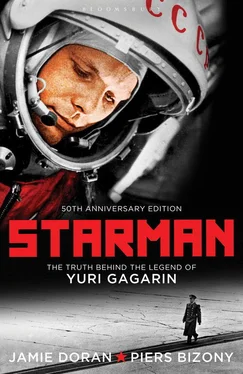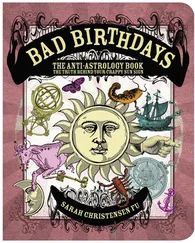Early on the morning of April 14 Gagarin left for Moscow. He climbed the gangway of a large Ilyushin-18 airliner capable of long-distance flights. In a few weeks’ time he would no longer think of this sturdy machine as an IL-18 any more; with weary humour he would be calling it ‘home’.
Much of his time during the flight to Moscow was taken up with journalists’ questions. Messages of congratulation were coming in via the radio in the cockpit, and the aircraft’s crew took turns coming into the passenger cabin for a few words. As the plane approached its destination after four hours’ steady progress, Gagarin took time out to gaze through his window. He saw his old life shooting past him in the sky, and a new and more complex life waiting on the ground:
We were escorted towards our landing in Moscow by a squadron of fighter planes. They were lovely MiGs, just like the ones I used to fly. They came in so close to us that I could clearly make out the pilots’ faces. They were smiling broadly, and I smiled back. Then I looked below and gasped. The streets of Moscow were flooded with people. Human rivers seemed to be flowing in from every part of the city, and over them, sail-like red banners waved on their way towards the Kremlin. [8] Gagarin, The Road to the Stars , quoted in Golovanov, Our Gagarin , pp. 187–8.
The Ilyushin touched down at Vnukovo Airport earlier than expected. Gagarin had to stay aboard for a few minutes until the pre-planned schedule of celebratory events was due to start. He felt happy but nervous.
Down on the ground, Valentin, Boris, Zoya and Alexei had met up earlier with Nikita Khrushchev and his wife Nina in Moscow, where they had already caught up with Anna and Valya. Zoya remembers a great deal of kindness from the First Secretary and his wife. ‘He was very simple and down-to-earth with us, and she spent all her time with us. We spent four days in Moscow, and every morning Nina would come round to us and only leave in the afternoon. It was a very liberal situation.’
The first formal event took place at the airport. ‘We stayed in Moscow to have some rest, and then on the fourteenth they took us to Vnukovo to meet Yura. We had just arrived, and we saw a plane with an escort of fighters, and they told us it was Yura’s. But when it landed he didn’t come out for some while, so we started to worry. Nina Khrushcheva said, “Don’t worry, the plane arrived a little earlier than planned, but as soon as the time comes, your Yura will come out.” And truly, in a few minutes he came out.’
They had laid out a long red carpet. (Nina Khrushcheva told Valentin, ‘Usually it’s a blue one.’) Yuri walked down the gangway and onto the carpet, looking every inch the hero in his brand-new Major’s uniform and greatcoat, but Zoya immediately noticed something terrible. ‘I saw something dragging on the ground behind him. It was one of his shoelaces.’ Gagarin noticed it too, and spent the interminable ceremonial walk along the carpet silently praying that he would not trip over and make a fool of himself on this of all occasions. He told Valentin later that he had felt more nervous on the carpet than during the space flight. But he did not trip. Incidentally, the shoelace can be seen in the many commemorative films of the day’s events. The cosmonauts’ official cameraman, Vladimir Suvorov, noted in his diary the endless discussions later about whether or not to edit the film and remove the scenes showing the untied shoelace. Eventually, at Gagarin’s insistence, the shots were preserved as a sign of his ordinary, lovable humanity. The ‘mistake’ turned out to have its own special propaganda value. [9] BBC archive footage, originally from a live broadcast on April 14, 1961 – the first live Western television broadcast from within the USSR – clearly shows the flapping shoelace.
A smiling, sure-footed Gagarin reached the flower-decked reception platform in one piece, greeted Nikita Khrushchev and other senior Party officials, then hugged his family. Valya gamely awaited her turn in the queue for a hug and a kiss. Alexei and Anna were dressed in their simple rural clothes, looking almost deliberately dowdy. They would rather have worn something smarter, but Khrushchev was most anxious to display them as humble peasant folk. Anna was in tears of pride, but Gagarin must have known how frightened she had felt over the last day or so. He hugged her, wiped away her tears with a handkerchief and said in a mock-childish voice, ‘Please don’t cry, Mamma. I won’t do it again.’
The ceremony at Vnukovo was quite brief. The more important event of the day was in central Moscow. The Gagarins and the Khrushchevs boarded a black Zil limousine and headed for Red Square. Zoya thought her famous brother looked pretty much the same as usual, if rather tired and pressured.
That day Gagarin was assigned a rare privilege, a personal driver. Fyodor Dyemchuk collected from the authorities a brand-new Volga-21 car, complete with the latest and most fashionable accessory: a third foglamp. From now on, he and the Volga would be assigned permanently to Major Gagarin.
Sergei Korolev was not so well treated. He also met Gagarin at Vnukovo, but the Chief Designer was standing slightly to one side of the main reception group, and Khrushchev made no obvious move to acknowledge the man who, more than any other, had made this triumph possible. Korolev was not granted a bright, new Volga car. He bought an older Chaika limousine from one of the foreign embassies, so that he could at least get himself to Vnukovo in reasonable style, for no one else seemed much concerned to put him on display. He was a State secret. He could not be spoken of, let alone paraded in public. They would not even let him wear his medals. To cap it all, his second-hand Chaika broke down on the way to Moscow when the fan belt snapped, and he was forced to hitch a lift to Red Square in a more modest vehicle. In the long official list of scientists, soldiers, Academicians and politicians attending the celebration to mark man’s first journey into space, Korolev’s name does not appear. His colleague Sergei Belotserkovsky says today, ‘The situation for Korolev was very unfair, and Yura was upset by that. The Nobel Prize Committee asked if they could make an award for the creator of the world’s first satellite and the man who’d sent the first human into space, but the authorities never replied to them. Even today that injustice hasn’t been remedied.’
In Red Square, Gagarin and his family stood alongside Khrushchev and the other Party leaders on the traditional perch of communist power: the reviewing stand atop Lenin’s Mausoleum. Overhead, helicopters flew over the city’s major thoroughfares dropping leaflets. The Red Army clumped and thumped across a cleared area of the square, but the greater allocation of space was given over to an immense cheering crowd. The fac^,ade of the GUM department store was obscured by a huge portrait of Lenin inscribed with the slogan, ‘Forward to the Triumph of Communism!’ Today, at least, that triumph seemed well within the bounds of possibility.
Not that much propaganda work, other than simply stating the facts, needed to be done to boost the day’s glory. The Soviet Union had put a man into space. Nikita Khrushchev’s senior aide and speechwriter Fyodor Burlatsky remembers, ‘I was in tears, and many people in the streets were crying from the shock – a shock of happiness, first of all because a man was flying in heaven, in the realm of God, and most important, because he was a Russian. The mood of celebration was almost entirely spontaneous. Usually in Russia, during Stalin’s time, and even during Khrushchev’s time, these demonstrations of popular feeling were heavily orchestrated, but this one wasn’t. It was natural, straight from the heart of maybe ninety per cent of people in the Soviet Union.’
Читать дальше












